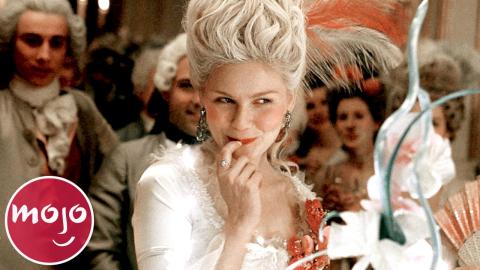Top 10 Movies with Historically Inaccurate Premises

#10: “Amadeus” (1984)
Wolfgang Amadeus Mozart is regarded as one of the best composers of all time, so it's plausible that he had some haters during his lifetime. This hypothesis is the basis for the 1984 period piece, "Amadeus," which suggests there was rivalry between Mozart and composer Antonio Salieri. Having died at age 35, it's been a long-standing theory that he was murdered, and the film suggests that Salieri plotted it. However, there's no hard evidence proving that the two were enemies. The play that the film is based on, "Mozart and Salieri," by Alexander Pushkin, took it a step further and depicted Salieri murdering "The Magic Flute" composer. But these inaccuracies didn't stop the film from winning an Academy Award for Best Picture.
#9: “Argo” (2012)
Directed and starring Ben Affleck, 2012's "Argo" may be based on a true story, but to call it factual is a stretch. The thriller is adapted from CIA officer Tony Mendez's book "The Master of Disguise." The material centers on how the author and his team pulled off the heroic rescue of American diplomats in Iran by going undercover as a film crew from Canada in the 80s. The film received a fair bit of backlash for underplaying Canada's prominent role in the operation. It also depicts Britain and New Zealand as refusing to help the United States when in reality, they collaborated with Canada. Even former American President, Jimmy Carter, called out the film for giving too much credit to the CIA.
#8: “The Sound of Music” (1965)
Top 10 Most Historically Inaccurate Costumes in Movies
"The hills are alive with the sound of music"...and lies! The beloved musical "The Sound of Music" is based on a book from the real-life Maria von Trapp. The cinematic adaptation took many liberties with the story, leaving out the fact that Maria and the Captain had three more children together. However, the most significant change is the ending. During the iconic finale, Maria and her new family escape Austria and the Nazis by traveling over the Swiss Alps. In reality, the family escaped through Italy, traveling by train and not on foot.
#7: “Anastasia” (1997)
The Amazing True Story of Anastasia
One of the biggest conspiracy theories in history is the truth surrounding the murder of the Russian Imperial family, the Romanovs. For decades, these rumors of a lost Romanov daughter ran wild. Many came forward years later claiming to be her, and this theory was the premise of the 1997's movie "Anastasia." But in reality, the film deviated from the truth. First, Anastasia wasn't a princess but a Grand Duchess. Also, the film's villain, Rasputin, was actually super close with the family, and the entire timeline of the film is way off. The most significant fabrication is that in 1991 DNA proved the real Anastasia did die during that tragic event in 1918.
#6: “Shakespeare in Love” (1998)
Top 10 Movies You Didn't Know Were Inspired by Shakespeare
2011’s “Anonymous” takes the mystery of William Shakespeare's life and asks: “What if?” But long before that film, there was 1998's "Shakespeare in Love," and as you can guess from the title, it’s about his love life. While the filmmakers never claimed to be making an accurate depiction of the Bard, there are still some facts they completely glossed over. For example, the dates mentioned in the dialogue are all over the place. The film's end depicts a character leaving England for an American colony in 1593, which didn't even exist yet. Also, Queen Elizabeth never attended a performance at an Elizabethan Theatre; instead, players traveled to her. We'd probably need to make another video to get through all of "Shakespeare in Love's" false truths.
#5: “Marie Antoinette” (2006)
Top 10 Behind the Scenes Facts About Malcolm & Marie
When Sofia Coppola's biopic, "Marie Antoinette," was released in 2006, it became acclaimed for its use of costumes and makeup. Costume designer Milena Canonero even won an Oscar for replicating the 18th-century French Queen’s wardrobe. But like any biopic, only some things are spot on. For instance, the soundtrack features tracks from modern bands like The Cure, The Strokes, and Bow Wow Wow. The film, which takes place in the 1700s, also includes a shot of lavender Converse sneakers, which did not exist at the time. That being said, Coppola's approach to the film values aesthetics over facts. This bold move deserves major credit for shaking up the biopic genre.
#4: “Braveheart” (1995)
1995's "Braveheart" has become an award-winning film thanks to its epic battle scenes. However, the Mel Gibson directed and led piece could have been a better history lesson. It depicts the rebellion of William Wallace, a warrior determined to free Scotland from mighty England. The title alone makes viewers believe it was a nickname for Wallace, but it's actually attributed to Robert the Bruce. Everything from the weaponry to the blue face paint is also inaccurate. But one of the most significant errors is the iconic Battle of Stirling Bridge scene, which doesn't even feature a bridge!
#3: “Pearl Harbor” (2001)
When Michael Bay set out to direct 2001's "Pearl Harbor," it seemed that he was more interested in creating an action-packed war epic rather than a true story. The movie focuses on the bombing of a Hawaiian military base by the Imperial Japanese Navy Air Service in 1941 and stars Ben Affleck and Kate Beckinsale. Affleck's character, Captain Rafe McCawley, offers to fight alongside a British squadron, but as an American pilot, that would have been a big no-no. Besides that, the technology of some of the planes featured in the film wasn't even available at the time of the attack!
#2: “Alexander” (2004)
2004's "Alexander" was made with a whopping $155 million, but it seems most of that money went towards cinematic elements rather than fact-checking. The Oliver Stone epic about ancient Macedonian king Alexander the Great is riddled with false facts that leave audiences wondering if any of it is based on the truth. Many important moments, such as significant battles, are entirely missing. Stone even confessed that he mashed some battles together due to time constraints. One of the most talked about aspects of the film was Alexander's sexuality, even though historians aren't 100% sure how he was identified. In fact, upon the film's release, 25 Greek threatened to sue Stone for "suggesting" the ruler was bisexual. Before we unveil our top pick, here are a few honorable mentions. “300” (2006) Spartans Would Be Really Upset to Know Their Legacy Was Tarnished on Film “JFK” (1991) The Washington Post Once Called This Flick “America’s Most Dangerous Movie” “Newsies” (1992) “Now Is The Time to Seize the Day” & Get Your Facts Straight! “The Greatest Showman” (2017) P.T. Barnum Is Portrayed as a Hero, But in Reality He Was More of a Villian “Titanic” (1997) “Titanic” May Have Broken Records, But It’s Hardly a History Lesson
#1: “Pocahontas” (1995)
Top 10 Historically Inaccurate Details in Pocahontas
While Disney is known for making cinema's most magical stories, its take on the story "Pocahontas" is straight-up problematic. Released in 1995, the animated musical tells a fantasy version of Amonute or Matoaka, aka Pocahontas, a Powhatan woman. The film depicts her as an adult during the founding of the Jamestown colony in the 1600s. But she was only around 10 or 11 at the time. It also shows a romance between her and colonizer John Smith. In reality, she ended up marrying a man named John Rolfe. The film ends with Smith leaving and Pocahontas staying with her tribe. The truth is she ended up in England with Rolfe and, during her return to America, she fell ill and died before turning 22.






